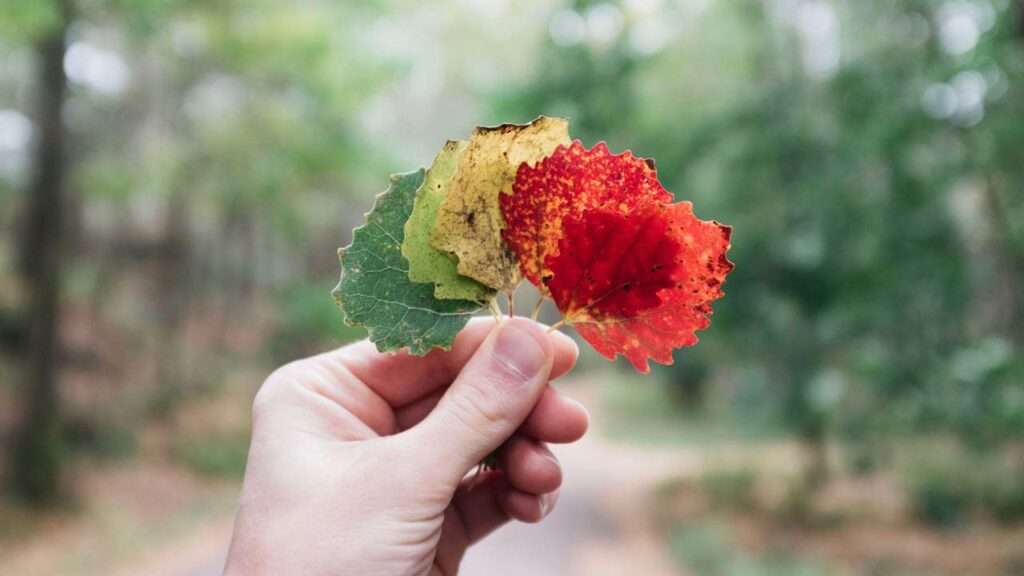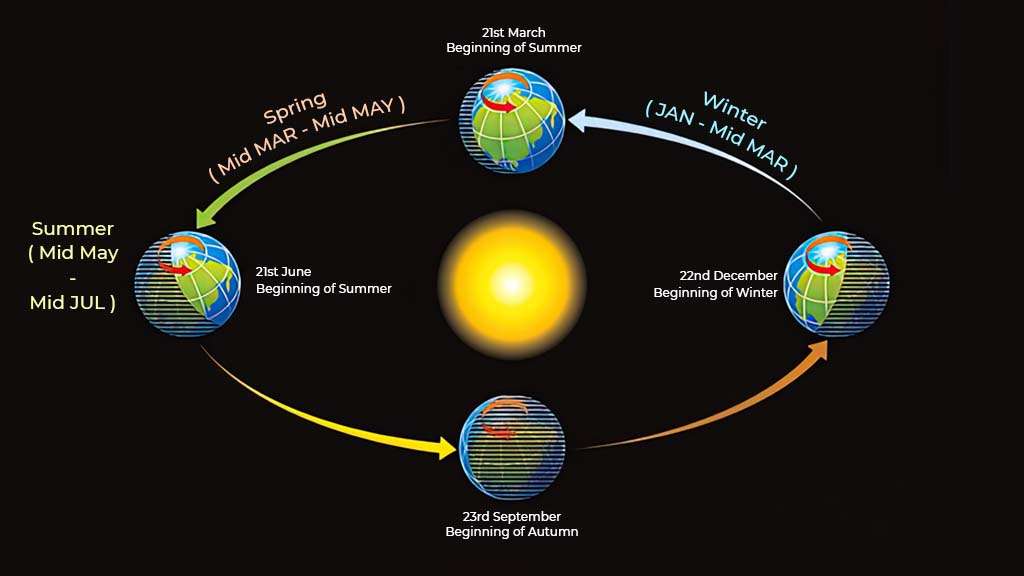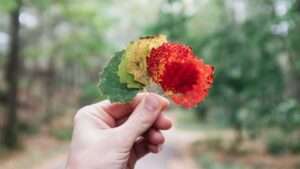An introduction and complete guide to the Ayurvedic seasonal routine – Ritucharya

The environment around you changes with the advent of every season. The temperature, vegetation, humidity, atmospheric pressure etc. get affected considerably. Likewise, the changing seasons affect your body and its processes. Ever noticed how that greasy food digests better in winters but may cause acidity on a hot summer day? That’s because your digestive & metabolic process (agni) functions differently in each ritu, as do other bodily processes.
As per Ayurveda, your body is a smaller version of the cosmos. It recognizes that there ought to be changed inside your body, with the changing outer environment. To maintain your body’s homeostasis to protect your physical and mental wellbeing with the changing seasons, Ayurveda suggests a comprehensive seasonal routine called Ritucharya. Following these season-specific ayurvedic regimes will help to maintain optimum health by adapting effectively to the changing environment. Here is a closer look at the ritucharya i.e. the recommended regimes for each season.
Ritucharya In Ayurveda
The term ‘Ritucharya’ is derived from the combination of two words: ‘Ritu’ which means season and ‘Charya’ which means routine. Thus, the ayurvedic routine designed according to the seasonal cycle is called Ritucharya.
During each season, certain elements amongst the Panchamahabhutas (the five basic constituents of the cosmos as per Ayurveda – air, water, fire, earth and sky) are predominant. This predominance of the elements is considered to affect your physiology and psychology. The physical strength, digestive power and overall response of your body change with each season. Each season(ritu) acts as ‘nimitta karana’ (reason or cause) for the aggravation of one of the three doshas in your body. Eventually, the aggravation of dosha makes your body susceptible to diseases.
Following the alterations in your diet, dressing, daily practices and lifestyle as a whole, as recommended by the ritucharya for that season, helps to maintain the balance of doshas and therefore, your physical and mental strength and vitality.
Ritucharya And The Division Of An Year
As per Ayurveda, a year is divided into two periods or ‘ayana’ – meaning solstice, which depends upon the movement of the Sun. Uttarayana (northern solstice) and Dakshinayana (southern solstice) are the two solstices that consist of three seasons each.
मासैर्द्विसंख्यैर्माघाध्यैः क्रमात् षट् ऋतवः स्मृताः
शिशिरो अथ वसन्तश्च ग्रीष्मो वर्षशरद्हिमाः
The above verse from Ayurveda mentions the division of one year into six seasons, called – Shishira(winters), Vasanta (spring), Grishma (summer), Varsha (rainy), Sharad (autumn) and Hemanta (pre-winter). Each Ritu comprises two ‘masas’(months).
Uttarayana – The Northern Solstice

The sun ascends northwards in Uttarayana which is also called Adana Kala or summer solstice. The Sun and wind are powerful during this period. Sun rays are more penetrating and the heating properties are strengthened by the wind. The overall temperature rises during the Uttarayana. The strength of your body reduces in this period of ritucharya.
The Uttarayan consists of the following ritus: Shishira (winter), Vasanta (spring), Grishma (summer). The period of Uttarayana ranges from mid-January to mid-July.
Shishira (Winter)
Period: Mid-January to mid-March
The environment is cold, windy and the dryness increases with the start of Shishira ritu. The strength of your body decreases but the digestive fire (Agni) is more powerful. The deposition of Kapha dosha occurs in your body.
Diet Inclusions
Your diet should have milk and milk products, cereals, pulses, rice, corn, along with sugarcane, ginger and garlic
Diet Exclusions
Pungent, astringent and bitter foods including cold and light food should be avoided.
Lifestyle Do’s
Bathing with lukewarm water, oil massage, exercise, wearing warm clothes, exposing your body to sunlight should be a part of your daily routine.
Lifestyle Don’ts
Vata aggravating processes like excessive walking or travelling should be avoided.
Vasanta (Spring)
Period: Mid-March to mid-May
Life on earth flourishes as spring (Vasant season) arrives. The atmosphere becomes pleasant, the Sun shines brighter and the heat increases. Vitiation of Kapha dosha occurs in the Vasanta season. The strength of your body is medium during this period. Whereas, the strength of the digestive fire (Agni) decreases.
Diet Inclusions
Bitter, pungent, astringent foods along with wheat, barley, rice, lentils should be included in your meals. Fermented foods, buttermilk, and honey should also be consumed to have the best diet plan.
Diet Exclusions
Cold, sour, sweet food items like curd, cold drinks, etc should be avoided.
Lifestyle Do’s
Bathing with warm water, massaging your body with sandalwood powder or saffron, and applying collyrium should be a part of your routine in the season.
Lifestyle Don’ts
Sleeping during the daytime should be avoided.
Grishma (Summer)
Period: Mid-May to mid-July
The environment becomes the hottest with the advent of Grishma ritu. It is characterized by scorching heat waves. The strength of your body is lowered. The digestive fire (Agni) remains mild during this period and deposition of Vata dosha occurs.
Diet Inclusions
Rice, lentils, and jawar should be included in your diet. You should prefer eating foods that have a sweet taste. Cold food and fluids like cold water, fruit juices, buttermilk, milk should be a part of your regime.
Diet Exclusions
Salty, pungent, and sour foods should be avoided.
Lifestyle Do’s
Swimming and bathing with cold water, applying sandalwood paste or Agaru, sleeping a bit at day time and sitting under the moonlight is helpful in Grishma season. You should preferably wear lighter clothes during this period.
Lifestyle Don’ts
You should avoid doing too much physical work, rigorous or excessive exercise, drinking alcohol and frequent sexual activity during this season.
Dakshinayana – The Southern Solstice

The Sun moves towards the southern direction during Dakshinayana which is also called Visarga Kala or winter solstice. The Sun becomes less powerful in this period. The winds are colder and less dry as compared to the Uttarayana. The environment becomes unctuous and the strength of your body is enhanced.
The Dakshinayana consists of the following ritus: Varsha (monsoon), Sharad (autumn), Hemanta (late autumn). The period of Dakshinayana ranges from mid-July to mid-January. Let’s look at ritucharya for each season in these months
Varsha (Monsoon)
Period: Mid-July to mid-September
Varsha ritu is characterized by cloudy skies with rains. The atmosphere in this period becomes damp, cold and a bit gloomy. Such changes in the environment impair your digestive fire (Agni). The strength of your body decreases during this season. Deposition of Pitta dosha and impairment of Vata dosha occurs in your body.
Diet Inclusions
Sour and salty foods should be a part of your diet. Rice, wheat, old barely, masur, moong are suitable for eating during Varsha ritu. Fluids like buttermilk, milk, soup, and boiled water should be preferred.
Diet Exclusions
Heavy food which is hard to digest should be avoided, eg., meat.
Lifestyle Do’s
You should bathe with warm water, apply natural perfumes or scented powders to your body and fume your clothes with scented woods.
Lifestyle Don’ts
Excessive exercise, too much exposure to the Sun and sleeping during the day should be avoided.
Sharad (Autumn)
Period: Mid-September to mid-November
Sharad ritu is characterized by bright Sun and usually a clear sky. The strength of your body remains medium. Impairment of Pitta dosha occurs during this period. The strength of digestive fire (Agni) increases as compared to the Varsha ritu.
Diet Inclusions
You should prefer to eat sweet foods. Foods that are light and cool in nature should be included in your diet. Wheat, rice, jawar, chana, tur, moong, honey, milk, buttermilk etc are suitable for eating during Sharad ritu. The meat of chicken, pigeon, and goat can be included in your meals.
Diet Exclusions
Bitter and astringent foods should be avoided. You should stay away from fats, oils, and curd in this season.
Lifestyle Do’s
You should preferably bathe with cold water, do mild exercise, sit under the moonlight and wear light clothes during this season
Lifestyle Don’ts
You should avoid exposure to the Sun and winds, excessive eating and sleeping during the day.
Hemanta (Late autumn)
Period: Mid-November to mid-January
The environment becomes cold and winds are chilly in the Hemanta ritu. The strength of your body increases and remains high. Your digestive fire (Agni) is strengthened during this season. As the nights become longer, you start experiencing early morning hunger.
Diet Inclusions
A healthy diet plan for this season should include sweet, salty, sour and unctuous food. Wheat, rice, urad, pea, sesame, fermented preparations, milk and milk products like butter, ghee, curd should be a part of your meal. You should prefer drinking hot water and fruit juices.
Diet Exclusions
Light, cold and dry food should be avoided.
Lifestyle Do’s
You should massage your body and hair with oils followed by the application of saffron or musk powder. You should bathe with warm water. Wear heavy, woollen clothes, reside/stay at warm places.
Lifestyle Don’ts
Exposure to cold winds and sleeping during the daytime should be avoided for this period’s ritucharya.
The Takeaway
Environmental variations greatly affect the functioning of our minds and bodies. Therefore, the above-mentioned yearly regimen is meant to keep you healthy throughout the extreme seasonal changes of the Indian subcontinent.
Ritucharya according to Ayurveda provides a routine consisting of various rules, recommendations and regimen plans for diet and lifestyle to adapt to the seasonal changes. In this way, you can align your body to the seasonal cycle of nature to stay fit and healthy. Hence, Ritucharya ensures the promotion of health without the interference of medicines.
It is beneficial to choose a correct seasonal or daily routine as per your prakriti and the present levels of doshas in your body. Hence, it is advisable to consult an ayurvedic practitioner before choosing an optimized routine for yourself.
FAQs
Ritucharya helps maintain your health during the change of seasons. However, most recommendations in ritucharya are based on the environmental changes that occur throughout the year in the Indian subcontinent only.
Since every place has its own climate – therefore the food and lifestyle that should be followed for a healthy balance of tridoshas should be adjusted according to the region you live in. If you are still confused, it is advised to consult an ayurveda expert who can guide you according to your prakriti and your local climate.
Ritucharya is needed to balance the seasonal effect on our bodies. However, each person also has their own prakriti based on the three doshas which should always be taken into consideration when planning the seasonal diet or lifestyle routine. Consult an ayurvedic expert for making any significant changes to your lifestyle or regimen. A recommended diet for each dosha type to help you with what kind of foods or routine to follow.
During hot days of summer, our body tries to cut down excess heat generation due to metabolism. That is why Ritucharya recommends foods that are easy to digest and have a cooling effect on the summer diet.

